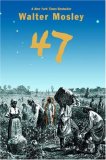Summary | Excerpt | Reading Guide | Reviews | Beyond the Book | Read-Alikes | Genres & Themes | Author Bio

This article relates to 47
According to Mosley, "Tall John himself is a reflection of an old slave myth about a spirit named High John the Conqueror. High John, the myth goes, came from Africa to confound the white masters and to ultimately free the slaves."
Zora Neale Hurston writes of High John de Conquer (pronounced conker) in The Sanctified Church, a collection of essays on Afro-American folklore, legend and myth with a particular focus on the spiritual character of the Southern Black Christian Church. She depicts him as a trickster/shaman figure (similar to Anansi and Br'er Rabbit) who is said to have been an African prince sold into slavery in the Americas, but whose spirit was never broken.
Another traditional story is told byVirginia Hamilton, in which John falls in love with the Devil's daughter; the Devil sets John a number of impossible tasks, but his daughter helps John by giving him magical tools to complete the tasks and also warns John that the Devil plans to kill him whether he succeeds or not. So John and daughter steal the Devil's horses; they're pursued but escape by shape shifting.
High John the Conqueror root is apparently one of the staples of African-American folk magic. It is the root of Ipomoea jalapa (an evergreen climber that grows to about 3 meters that belongs to the same family as morning glory and sweet potato) and is used in Hoodoo, a folk version of the religion of Voodoo, that focuses on herbal magic. Apparently the root is considered to bring good luck in gambling and is used in spells to do with sex; it is also a popular component of a mojo bag (a small flannel bag containing one or more magical items, worn by followers of hoodoo and voodoo). When dried, the root resembles the testicles of a dark skinned man - hence it is extremely important for good mojo that the root be whole and unblemished!
Filed under Cultural Curiosities
![]() This "beyond the book article" relates to 47. It originally ran in June 2005 and has been updated for the
November 2006 paperback edition.
Go to magazine.
This "beyond the book article" relates to 47. It originally ran in June 2005 and has been updated for the
November 2006 paperback edition.
Go to magazine.
If we did all the things we are capable of, we would literally astound ourselves
Click Here to find out who said this, as well as discovering other famous literary quotes!
Your guide toexceptional books
BookBrowse seeks out and recommends the best in contemporary fiction and nonfiction—books that not only engage and entertain but also deepen our understanding of ourselves and the world around us.